My friend Cort Buffington doesn’t have an active blog of his own but is doing interesting things with 110VAC light bulbs and is looking for ways to migrate to LEDs.
What follows is a write-up of his tests with LEDs and ping-pong-ball diffusers.
Cort’s Quest for 10W Sign Bulb Replacements
For some time I’ve been trying to figure out how to make an LED equivalent to a 10W colored sign bulb. Whether it be the G style intermediate base or the S style medium base. The big problem has been a diffuser. Sign bulbs are meant to be looked at, not to illuminate other things, so this is of paramount importance. I very quickly came across a LOT of information online with folks using ping pong balls, and Keith was just as eager as I to try this out. The initial tests with ping pong balls worked…. sort of. Ping pong (or beer pong if you’re in college) balls do work, but there are a couple of immediate problems:
Brightness
Trying to get a light level similar to a sign bulb with an LED in a ping pong ball is a trick. Well diffused LEDs aren’t bright enough, while so called “super-bright” LEDs often have entirely too narrow of a beam, resulting in hot/cold spots on the ball. I have read many a post with folks scuffing LEDs, cutting the ends off, etc. I tried all of these methods, and while they do work, they weren’t producing the results I wanted.
So what did I do? Nothing scientific to be sure. I went through my drawer of assorted LEDs and nothing was looking good. Then I happened to pop an odd shaped (cylindrical) white LED that Keith “loaned” me into the ball and bazinga! It worked perfectly. I immediately contacted Keith to get info on where he got the LED. As it turns out, there are cylindrical (not inverted cones, but completely cylindrical) LEDs that have very close to a 180 degree beamwidth. I purchased several colors from C-LEDs from this category and they work perfectly. While there, I found they also have super-bright diffused LEDs in this category which work almost identically, despite very different mcd ratings.
Everything worked except for the yellow. I could not get a good yellowy yellow or find one bright enough…. and one other nagging problem. The white balls reflect room light really well. So unlike a light bulb, they wash out in room light very quickly with colored LEDs in them. If the room is dark, they’re great, but it doesn’t take too much light for the ambient light reflection to start competing with the interior illumination.
Colored Ping Pong Balls
In order to fight the white-ball-illuminated-by-ambient-light problem, I ordered some colored ping pong balls. I also had an idea that I would use a super-bright white LED inside a yellow ball to overcome the yellow brightness problem. I had tried dying, coloring, painting…. nothing worked to make a white ball a colored ball (that looked good with an LED in it) other than just buying colored balls.
Unfortunately, I now had a new problem. I fixed the yellow issue, but now red was dismally dim. Blue wasn’t that great either, but I could live with it. I also immediately grew to like the colored ball appearance when the LED is not on also. But what to do about red?
Back to Colored LEDs
This was the final solution to the problem. I found by inserting a red LED into the red ball, the brightness came WAY up. Perfect. In fact, this technique helped out the blue as well, while yellow and green both looked best using a white LED in a colored ball.
There is a bit of variance in the luminosity of the balls now, but not much, and a variance easily fixed by reducing the current to the brighter two colors just slightly. The photo above shows the finished “product” in a dark room. Note there are some “challenges” with the CCD in my camera, the far left is green and far right is blue. In addition to some color problems, the camera also shows “hot spots” on both the red and blue balls that are not actually present.

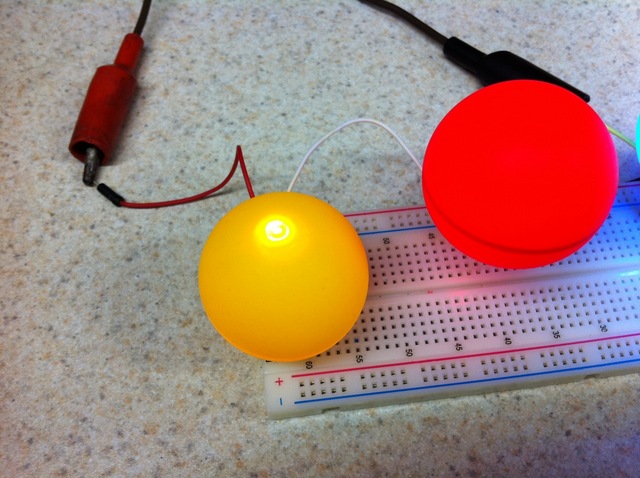
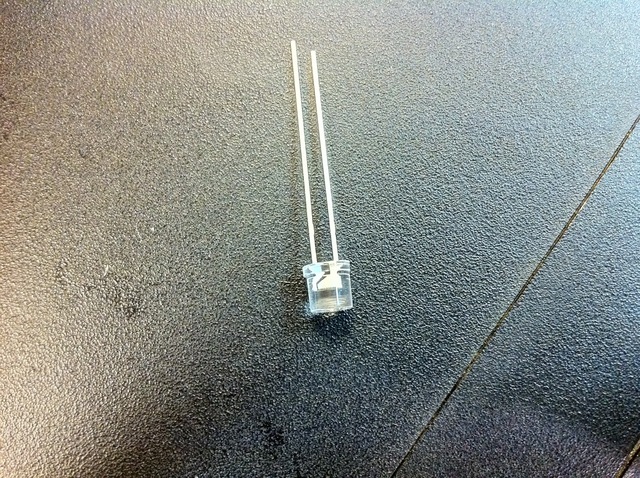
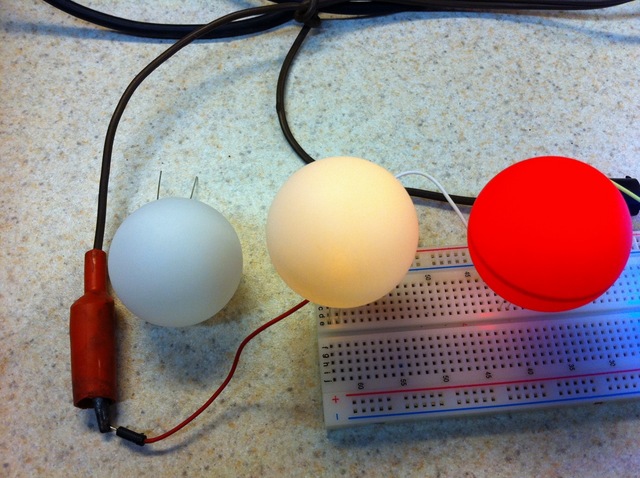
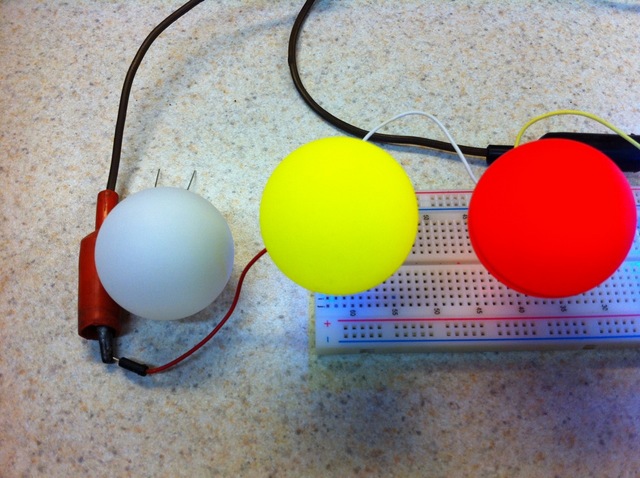
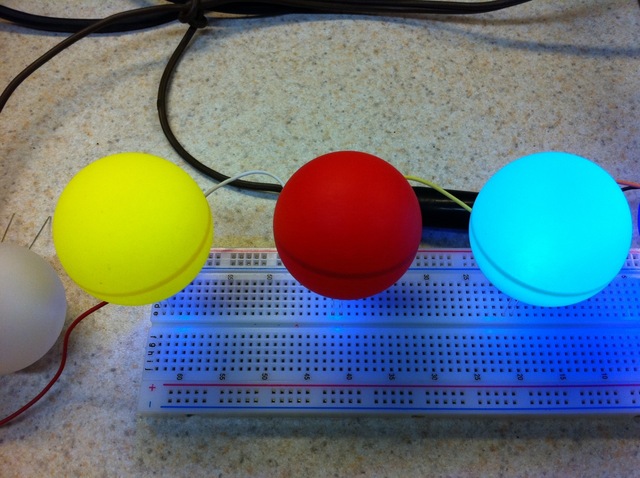
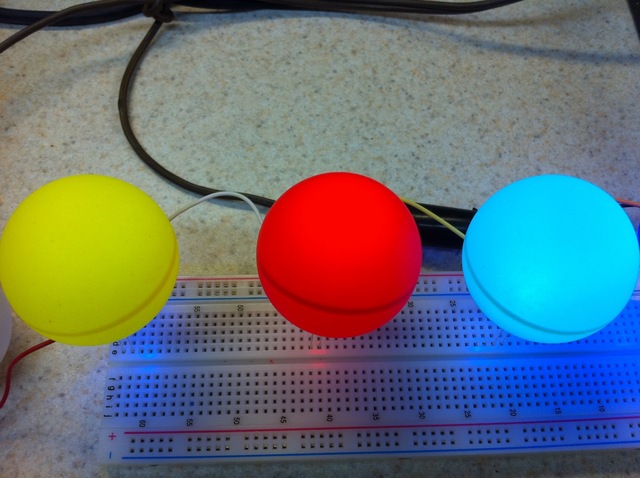
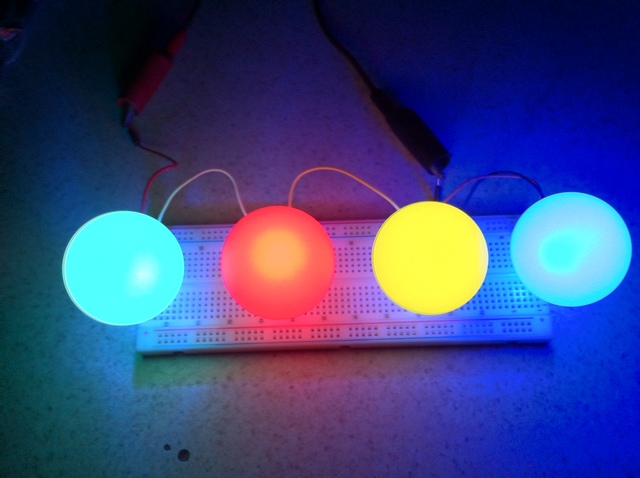
One diffuser I’ve had promising results with is 3/4″ solid polypropylene balls. This is more or less the same plastic milk jugs are made of, and is very diffuse – it does a good job of mixing RGB colors. They’re $0.10/each from US Plastic.
I still need to come up with a nice way of drilling holes in them (some sort of drill press jig) and mounting them, but basic test results looked very good. Much less overall light loss than the ping-pong balls.
The rod stock is another possibility that might be easier to work with.
Where do you get the (colored) ping-pong balls from? I’m looking for a source for 300+ balls..
I saw a LED-matrix with ping-pong balls on a french website. They solved the diffusing problem by ‘not drilling into the balls’. This way the bottom of the balls are used as first diffusing stage.
I bought my colored ping pong balls from glowstickfactory.com. They were not economically priced, but I was able to get the small quantity I needed for testing.
And thanks for the tip on the polypropylene balls J. Peterson! I’m going to go look at them. I’m specifically chasing a 10w sign-bulb replacement right now, so 3/4″ is a bit small, but still worth looking at for other projects. Sounds very promising.
Cort – I’d love to hear how they work out if you get a chance to use them. The balls are available in various sizes up to 1″, though I don’t know if light loss is an issue at larger sizes.